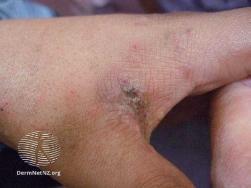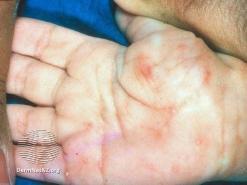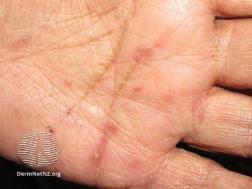Scabies - Frequently Asked Questions
Translated resources for scabies are available.
What is scabies?
Scabies is a very common itchy skin condition caused by a tiny mite. Anyone of any age can get scabies; it is not caused by poor hygiene. Scabies can easily spread from person to person through skin-to-skin contact, including during sexual contact. Once infected, it can take 3 to 6 weeks for symptoms to occur and can spread to others during this time. The usual kind of infection is called ‘classical’ scabies. With this type of scabies people get a very itchy skin rash, which is due to an allergy to the scabies mite.
Less commonly, a type of scabies known as crusted scabies can occur, due to an increased number of mites in the skin. Crusted scabies is highly contagious and is more likely to affect elderly people or individuals with a poor immune system or mobility issues.
What are the symptoms of scabies?
Scabies causes itching, which can affect the whole body, and can be worse at nighttime or after having a bath. A rash can be seen in affected areas of skin; in particular it may be seen in skin folds, for example between fingers and toes.



Images courtesy of: DermNetNZ.org
How does a person become infected with scabies?
Scabies mites pass easily from one person to another when people have skin-to-skin contact, such as groups of people living in family homes, residential and nursing homes. Scabies can be transmitted during sexual contact. Health care professionals, in particular nurses and carers, may catch scabies when providing care to patients who are infected.
It is unlikely to spread if contact with the skin is brief such as when shaking hands. Longer contact with the skin is needed but could be as little as 5 to 10 minutes. Although it may take 3 to 6 weeks after becoming infected with scabies before symptoms appear, scabies may be passed on to others during this time.
Does scabies require treatment?
Yes. Scabies is not usually a serious condition, but it requires correct management (treatment with skin creams and killing any mites that may be in your clothes, bedding and other personal items) to cure it and prevent further spread. If you think you have scabies, talk to your GP or pharmacist. They can provide you with skin creams and information around additional measures required to treat and clear the infection.
What should I do if I have scabies?
- If you think you have scabies, seek advice from your GP or pharmacist and follow the treatment and management recommendations promptly. Normal washing or washing/showering with disinfectant does not prevent or treat scabies.
- Scabies is usually treated with creams applied directly to the skin in addition to other measures. To ensure successful treatment it is essential that you apply the prescribed cream correctly following the manufacturer’s instructions and leave it on for the recommended duration of time. A second application is required one week later to complete the treatment.
- Following the first application of cream, all clothing, bedding and towels should be washed in a minimum 50 degrees Celsius wash cycle or put in a tumble dryer for 30 minutes at a minimum of 50 degrees Celsius to destroy mites. Alternatively, items can also be sealed in a plastic bag for 4 days. These may include items which have been exposed to prolonged direct contact with the skin, for example shoes, coats, hats, soft toys and removable covers of child car seats and buggies. Other items, such as mattresses and car seats, which have had prolonged direct contact with skin can be vacuumed.
- If you have genital scabies, then tests for other sexually transmitted infections (STIs) are recommended. Free STI testing is available at HSE public STI clinics and through the HSE home testing service
If I have scabies, who else should be treated?
If you have scabies, it is possible that other household members and sexual contacts may also have it, even if they do not have symptoms. It is really important that all household members you have close personal contact with, and your sexual contacts are informed and that they follow the same advice on treatment and management of clothes, bedding etc. Anyone who requires treatment should be treated at the same time as you. In this way the infection can be cured and will not spread further.
When can I or my child return to work/school?
You or your child can return to school, creche or work 24 hours after the first application of cream.
How long do symptoms last following treatment?
Itching may continue following treatment. Your GP or pharmacist can advise you on treatments to help relieve itching. Seek further medical advice if there is no improvement after 4 weeks following correct application of treatment and completion of other recommended measures, or if there are signs of a skin infection (skin may be red, sore or hot).
If I have had scabies previously, can I become infected again?
Yes. If you previously had scabies, you can become infected again. With repeat infection the rash may appear much quicker, from 1-4 days after being reinfected. To prevent reinfection, it is important to ensure that you, your household contacts with whom you have close personal contact and your sexual contacts are treated correctly and follow all recommended measures.
For further information see “Scabies Expert Advisory Group report of consensus on clinical, environmental, infection prevention and control, and contact tracing parameters for scabies”.
Last updated:26 February 2024


